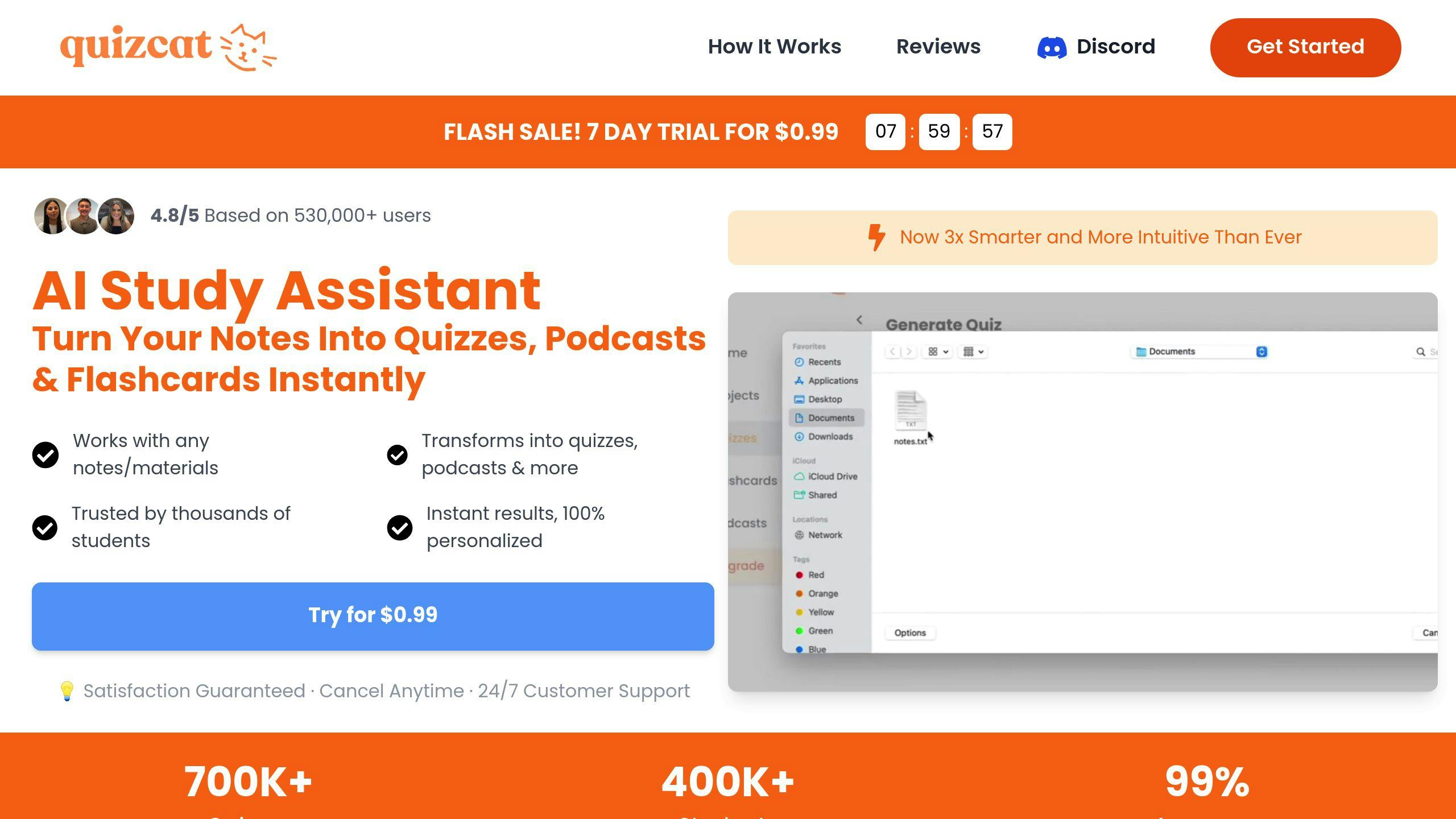
Best Practices for AI in Collaborative Learning
AI is transforming group learning by solving common challenges like uneven participation, team conflicts, and performance tracking. Here’s how it helps:
- Balanced Teams: AI forms groups based on skills and learning styles.
- Conflict Management: AI tools monitor and resolve group issues in real-time.
- Personalized Support: Virtual agents guide discussions and tailor learning paths.
- Interactive Tools: Platforms like QuizCat AI turn study materials into quizzes and flashcards for better collaboration.
Key Takeaway: AI enhances teamwork and learning outcomes while addressing privacy and ethical concerns. Use AI as a support tool, not a replacement for educators.
ChatGPT & Generative AI for Collaborative Learning
Using AI Effectively in Group Learning
AI tools can help address challenges in group learning by improving collaboration and resolving conflicts efficiently. Here's how these technologies can be used to their full potential.
Forming Balanced Learning Groups with AI
AI can analyze factors like learning styles, subject expertise, and communication habits to create well-rounded teams. These groups are designed to encourage mutual support and effective collaboration [1][3].
AI for Group Moderation and Conflict Resolution
AI tools monitor group participation, identify conflicts, and suggest solutions in real time. By encouraging balanced input from all members, these tools help maintain a productive environment while teaching students how to navigate disagreements [1][3].
AI Virtual Agents as Learning Guides
AI-powered virtual agents assist group learning by offering instant access to information, guiding discussions, and tailoring support to meet the needs of both individuals and the group [1]. These tools foster teamwork while helping learners stay on track.
For example, QuizCat AI turns shared study materials into interactive quizzes and flashcards, enabling teams to work together to identify and fill knowledge gaps [4][2].
Research by Dr. Erin Walker highlights the impact of AI virtual agents on group learning. These tools significantly enhance engagement and the quality of interactions [1].
"AI-powered virtual agents can supplement group discussions by providing expert knowledge and guidance, offering real-time assistance, generating fresh ideas, and providing personalized feedback to enhance learning outcomes" [1].
AI Tools for Group Learning
AI tools are reshaping how groups learn and collaborate. These platforms bring features that boost engagement and make sharing knowledge within teams easier and more effective.
QuizCat AI for Group Learning

QuizCat AI turns regular study materials into interactive formats, making it a standout option for group learning. With this platform, teams can transform shared resources into quizzes, flashcards, and even podcasts. This not only encourages collaboration but also helps deepen understanding. Plus, its mobile-friendly design keeps study groups connected, even when members are in different locations.
Other AI Tools for Collaboration
Beyond QuizCat AI, various AI platforms address other needs in group learning. For example, virtual assistants offer instant help with group questions, discussion boards analyze participation trends and suggest ways to improve teamwork, and language tools break down communication barriers for multilingual teams [1][4].
When using these tools, it's important for educators to integrate them into existing teaching methods rather than rely on them entirely. The goal should be to encourage meaningful interactions, with AI serving to enhance - not replace - the learning process [4][2].
These tools help groups tackle common challenges in collaborative learning, making teamwork more inclusive and productive. Choosing the right tools depends on matching them to specific learning goals and ensuring they work smoothly with existing systems while keeping data secure [4].
sbb-itb-1e479da
Challenges in AI-Powered Group Learning
Using AI in collaborative learning comes with its own set of challenges. These require thoughtful solutions to address concerns responsibly.
Protecting Student Data Privacy
As AI tools handle more student data, ensuring privacy is a top priority. To protect sensitive information, institutions should use platforms that comply with regulations like GDPR and FERPA. This includes encrypted data storage, strict access controls, and regular security audits. The goal is to strike a balance between using data effectively and maintaining strong privacy protections [1].
Ensuring Ethical AI Use
Ethics in AI-powered group learning go beyond privacy. It's essential to monitor AI systems for bias, keep decision-making processes transparent, and ensure human oversight. AI should support educators, not replace them, keeping instructors actively involved [2].
Accessibility also poses a challenge in three main areas:
- Learning abilities and styles: AI tools need to adjust to individual needs.
- Technical access disparities: Providing alternative resources can help bridge gaps.
- Language barriers: AI translation tools can assist multilingual teams [4].
Regular reviews of how AI is implemented ensure these tools meet their purpose without lowering educational standards [2]. Tackling these challenges allows educators to use AI effectively, improving group learning while staying ethical and secure.
Conclusion and Future of AI in Group Learning
Summary of AI in Group Learning
AI is reshaping collaborative learning by offering tools that make group experiences more personalized and engaging. Platforms like QuizCat AI bring interactive elements - such as quizzes and flashcards - that encourage collaboration and deepen understanding. The challenge lies in leveraging AI's potential while maintaining human oversight and addressing privacy concerns.
Research shows that AI-powered group learning boosts both engagement and knowledge retention. By tailoring approaches to individual needs, AI creates balanced learning environments where students can support each other's strengths. As technology progresses, AI's role in education will continue to grow, influencing how we approach teamwork and learning.
Future Trends in AI for Education
Emerging developments in AI are set to refine group learning even further, focusing on:
- Personalized learning experiences: AI will adapt to individual learning styles, tailoring group activities accordingly [1][3].
- Smarter moderation tools: Advanced AI systems will help manage group dynamics, resolving conflicts and guiding discussions with minimal need for educator intervention [1].
- Actionable analytics: AI will provide data-driven insights to improve learning outcomes while safeguarding privacy [2].
"These best practices provide a practical framework for integrating AI tools to enhance learning outcomes and foster human-AI collaboration." - genai.illinois.edu [2]
Institutions are increasingly adopting AI tools that balance privacy with performance insights. The focus of future AI advancements will include:
- Better accessibility features for diverse learning needs
- More effective real-time feedback systems
- Seamless integration with existing educational platforms
- Enhanced security measures to protect student data [4]
AI is set to make group learning more inclusive, ethical, and impactful.
FAQs
How can AI facilitate collaboration among educators?
AI tools can improve collaboration among educators by analyzing how teams work together and offering insights to refine group dynamics. These insights help teachers fine-tune their teamwork and teaching methods.
For example, QuizCat AI aids in creating collaborative curricula by transforming study materials into interactive quizzes and flashcards. This ensures uniformity across different teaching groups and helps educators align their methods while maintaining high-quality instruction.
"These best practices offer a practical framework for integrating AI tools to enhance learning outcomes and promote ethical AI use." - genai.illinois.edu [2]
Here’s a breakdown of how AI supports educator collaboration:
| Collaboration Aspect | AI Support | Impact |
|---|---|---|
| Content Creation | Automates material generation | Better student pass rates [5] |
| Group Management | Helps resolve conflicts and moderate discussions | More student engagement [5] |
| Performance Tracking | Pinpoints learning gaps | Enhanced academic results |
To make the most of these tools, integrate AI with existing campus systems, ensure materials are accessible to everyone, and adjust learning plans to meet diverse needs [4].
AI is a powerful aid but works best as a complement to human interaction, not a replacement. By simplifying collaboration, AI tools help educators align their strategies, keeping group learning environments productive and balanced for students.
